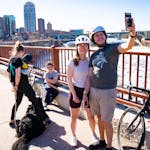The Thursday evening commute could get downright gnarly.
Aside from the normal crush of folks leaving work, four major sporting events — three in Minneapolis and one in St. Paul — plus the State Fair and students moving into dorms at the University of Minnesota will put thousands of extra vehicles on the traffic grid.
Metro Transit officials are bracing for heavy ridership, and they plan to have every bus and light-rail vehicle that they can find operators for out on routes.
It could be one of those commutes that require a lot of patience and "some soothing music," said MnDOT's Kirsten Klein. "There are going to be a lot more people out. Make sure you plan for a little longer commute than normal."
More than 66,000 fans will pour into downtown Minneapolis as the Vikings play their final preseason game at 7 p.m. at U.S. Bank Stadium. Ten minutes later, on the other side of downtown, the first pitch will be thrown at Target Field for the Twins-White Sox game. Across the river starting at 8, the Gopher football team kicks off its season with a game against Oregon State at TCF Bank Stadium. Altogether, the three events will draw more than 100,000 people to the city.
"It might be the busiest traffic day of the year," said Minneapolis city spokesman Casper Hill. "But it's good to have a bustling downtown."
The city will do its best to keep cars flowing by stationing 45 traffic control agents at key intersections near the three stadiums, Hill said. Streets immediately around U.S. Bank Stadium — namely Chicago Avenue between 4th and 6th streets along with 4th Street at Park Avenue — will be closed to motor vehicle traffic. Compounding matters is that westbound Washington Avenue, from Portland Avenue to Hennepin Avenue, is closed for street reconstruction.
University of Minnesota officials are warning fans to expect congestion on campus streets in the hours directly preceding and following the 8 p.m. game.
Fans heading to the 7 p.m. St. Paul Saints game may feel the least pain, but there will be street closures in the vicinity of CHS Field in downtown St. Paul.
It's rare that events at major venues take place on the same day in the Twin Cities, but it's not unprecedented.
Last year Metro Transit set a daily record by providing 109,900 light-rail rides on Sept. 3.
That night — also a Thursday — there were three games in town — the Gophers, Twins and Saints. It marked the first time daily ridership topped the 100,000 mark. The agency is expecting that to happen again on Thursday, said spokesman Howie Padilla.
"We are ready for it," he said. "We also will have service for people just trying to get home or on with everyday life, too."
By comparison, officials in Seattle try hard not to have kickoffs and tipoffs concurrently, said Norm Mah, a public relations specialist for the Seattle Department of Transportation.
On the rare occasion that the Sounders, Mariners and Seahawks have home games on the same day, an agreement among the teams calls for staggered start times.
If attendance at a soccer, baseball or football game is expected to be 20,000 fans or more, the agreement calls for a three-hour window from the projected finish time of the first game to the start of the second to help ease the traffic ingress and egress.
That rarity will happen on Sept. 17. The Sounders play a 1 p.m. game at CenturyLink Field.
The Mariners game at next-door Safeco Field won't start until 6 p.m. A football game at the University of Washington won't start until 5 p.m.
"It's rare that we have events happen simultaneously and the teams are very good about their schedules to avoid conflict," Mah said. "We work with the Seattle Police Department to control traffic and we ask fans to plan ahead."
In Philadelphia, there are no rules that prevent sports teams from hosting contests at the same time.
The city has hosted Flyers (hockey) and 76ers (basketball) games concurrently. And on occasion, the NFL's Eagles have played at the same time, too.
"Traffic is traffic and the fans put up with it," said Toni Kane, an administrative assistant in the city's transportation division.
"They are used to it. It's purely second nature."
Minneapolis' Hill suggested that fans consider taking transit or biking to help reduce congestion.
For those who choose to drive, MnDOT's Klein says drivers can check 511mn.org for current traffic conditions.
If maps are red, you'll still have to grin and bear it, "but at least you feel better when you know why," she said.
Tim Harlow • 612-673-7768




